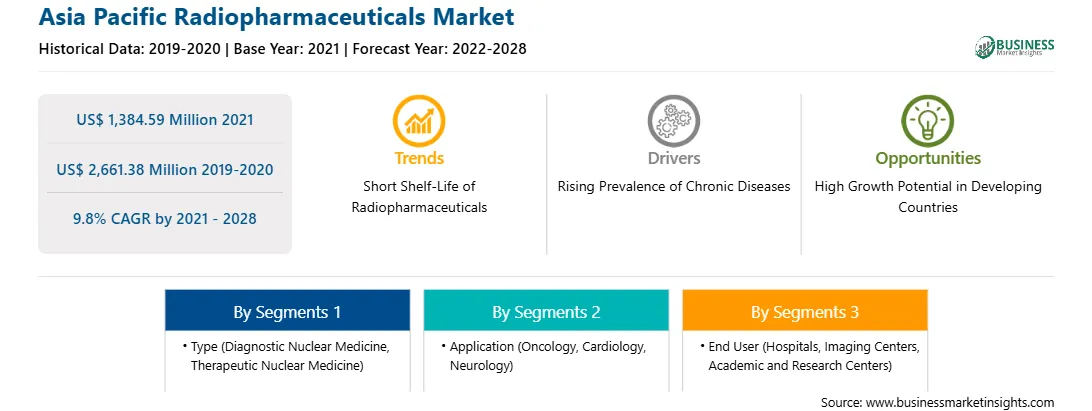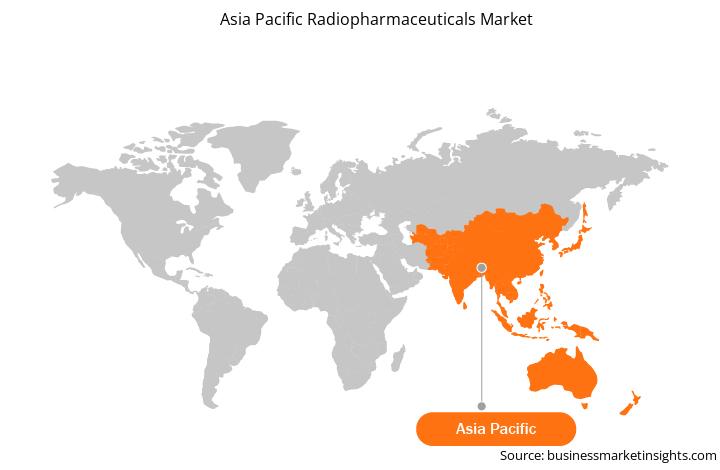APAC consists of five major countries namely China, Japan, India, Australia, and South Korea. The market is also evaluated for the rest of countries in Asia Pacific. Japan led the market during forecast period. During the recent years, Japan has been increasing its focus towards the field of nuclear medicine. Japan has entered the era of the fastest growing geriatric population; the growing ageing population has led to the transformation of the medical systems. For instance, as per the World Economic Forum, currently, there are 2.3 billion people in their 70s in Japan. The advanced health transition is seen in the country and is increasingly putting pressure on the sustainability of its health systems. The rise in the geriatric population is responsible for increasing the burden of diseases in the region. The government organizations and research institutes are involved in the manufacturing of radiopharmaceuticals. For instance, Dept. of Radiopharmaceuticals Development, a part of National Institute of Radiological Sciences, aims to develop radiopharmaceuticals that are useful for clinical diagnosis and treatment, developing new radio nuclides required for synthesizing drugs, and manufacturing labeling techniques. Soaring growth in emerging countries and rising use of nuclear medicines for personalized treatment are the major factor driving the growth of the APAC radiopharmaceuticals market.
In case of COVID-19, APAC is highly affected especially India. The medical practices in the region continue to adapt to the challenges of COVID-19. On the one hand, healthcare professionals are responding to the pandemic, and on the other, it ensures minimal disruption to non-COVID-related procedures and hospitalizations. Hospitals and other healthcare facilities worldwide are forced to postpone elective procedures, such as surgeries. Most non-urgent therapies have been postponed. The COVID-19 pandemic affected health care services in many dimensions, starting from interrupting the regular patient flow to health care facilities, stressing, and overwhelming the health care resources, and leading to the implementation of extra protective measures and social distancing with increased utilization of telehealth and virtual medicine. As a precautionary approach, oncology practices implemented specific measures to reduce the number of patients in outpatient clinics, reduce unnecessary or elective procedures, and discharge patients from inpatient services. This has negatively impacted the growth of the radiopharmaceuticals market in the region. In addition, market players have also been affected by the pandemic owing to supply chain contrarians and reduced demand. The Specialty Pharma segment, especially radiopharma, was impacted due to COVID-19 and competition in radiopharma. Even before the pandemic, Nuclear Medicine’s supply chain was highly complex, depending on the availability of raw materials, manufacturing facilities' operations, and air transportation reliability. Thus, the factors mentioned above are negatively impacting the radiopharmaceuticals market in the region.

Strategic insights for the Asia Pacific Radiopharmaceuticals provides data-driven analysis of the industry landscape, including current trends, key players, and regional nuances. These insights offer actionable recommendations, enabling readers to differentiate themselves from competitors by identifying untapped segments or developing unique value propositions. Leveraging data analytics, these insights help industry players anticipate the market shifts, whether investors, manufacturers, or other stakeholders. A future-oriented perspective is essential, helping stakeholders anticipate market shifts and position themselves for long-term success in this dynamic region. Ultimately, effective strategic insights empower readers to make informed decisions that drive profitability and achieve their business objectives within the market.

| Report Attribute | Details |
|---|---|
| Market size in 2021 | US$ 1,384.59 Million |
| Market Size by 2028 | US$ 2,661.38 Million |
| Global CAGR (2021 - 2028) | 9.8% |
| Historical Data | 2019-2020 |
| Forecast period | 2022-2028 |
| Segments Covered |
By Type
|
| Regions and Countries Covered | Asia-Pacific
|
| Market leaders and key company profiles |
The geographic scope of the Asia Pacific Radiopharmaceuticals refers to the specific areas in which a business operates and competes. Understanding local distinctions, such as diverse consumer preferences (e.g., demand for specific plug types or battery backup durations), varying economic conditions, and regulatory environments, is crucial for tailoring strategies to specific markets. Businesses can expand their reach by identifying underserved areas or adapting their offerings to meet local demands. A clear market focus allows for more effective resource allocation, targeted marketing campaigns, and better positioning against local competitors, ultimately driving growth in those targeted areas.

The APAC radiopharmaceuticals market is expected to grow from US$ 1,384.59 million in 2021 to US$ 2,661.38 million by 2028; it is estimated to grow at a CAGR of 9.8% from 2021 to 2028. The Targeted alpha therapy (TAT) is the latest and evolving technique used for local and systemic cancer treatment. Preclinical research and clinical trials prove that alpha-emitting radionuclides kill targeted cancer cells and do not harm the healthy cells (selective cytotoxicity). 211At, 213Bi, 225Ac, and 227Th are among the alpha-emitting radioisotopes used to label targeting vectors such as monoclonal antibodies; the monoclonal antibodies labeled with α-emitting radionuclides are emerging as an effective radioimmunotherapy. Shorter-range radioisotopes (α particles) are used for treating patients with hematological cancer. Alpha radiations are suitable for killing isolated cancer cells in the vascular and lymphatic systems as well as in regressing tumors by disturbing tumor capillary networks for targeting and killing tumor capillary endothelial cells (ECs). The Radium-223 dichloride alpha therapy is the only approved concept for internal alpha-emitting radioisotope cancer treatment. The decay of radioactive elements after reaching the malignant tissue releases tumor-destroying radiations without causing significant damage to the adjoining healthy tissues. The alpha radiations are much localized, and they penetrate a maximum of 2–10 cell layers. Healthy cells in the surrounding tissue can recover from any damage caused by the radiation to a certain extent themselves. Nuclear imaging uses gamma emitters that have a long lifespan, which allows blood clearance as the tumor increases its uptake of the conjugate over time, so improving contrast. Nuclear imaging agents allow the diagnosis of tumor and organs. In addition, the rise in awareness about alpha radioimmunotherapy and surge in the availability of therapies for cancer treatment procedures are propelling the demand for nuclear imaging. Thus, the preferred use of alpha radioimmunotherapy in the treatment of cancer is fueling the APAC radiopharmaceuticals market growth.
In terms of type, the diagnostic nuclear medicine segment accounted for the largest share of the APAC radiopharmaceuticals market in 2020. In terms of application, the oncology segment held a larger market share of the APAC radiopharmaceuticals market in 2020. Further, the hospitals segment held a larger share of the APAC radiopharmaceuticals market based on end user in 2020.
A few major primary and secondary sources referred to for preparing this report on the APAC radiopharmaceuticals market are company websites, annual reports, financial reports, national government documents, and statistical database, among others. Major companies listed in the report are Advanced Accelerator Applications; Bayer AG; Bracco Imaging S.p.A; Cardinal Health Inc; Curium; ECZACIBA?I MONROL NUCLEAR PRODUCTS CO.; GENERAL ELECTRIC; Lantheus Medical Imaging, Inc.; Nordion; and NTP RADIOISOTOPES.
The Asia Pacific Radiopharmaceuticals Market is valued at US$ 1,384.59 Million in 2021, it is projected to reach US$ 2,661.38 Million by 2028.
As per our report Asia Pacific Radiopharmaceuticals Market, the market size is valued at US$ 1,384.59 Million in 2021, projecting it to reach US$ 2,661.38 Million by 2028. This translates to a CAGR of approximately 9.8% during the forecast period.
The Asia Pacific Radiopharmaceuticals Market report typically cover these key segments-
The historic period, base year, and forecast period can vary slightly depending on the specific market research report. However, for the Asia Pacific Radiopharmaceuticals Market report:
The Asia Pacific Radiopharmaceuticals Market is populated by several key players, each contributing to its growth and innovation. Some of the major players include:
The Asia Pacific Radiopharmaceuticals Market report is valuable for diverse stakeholders, including:
Essentially, anyone involved in or considering involvement in the Asia Pacific Radiopharmaceuticals Market value chain can benefit from the information contained in a comprehensive market report.